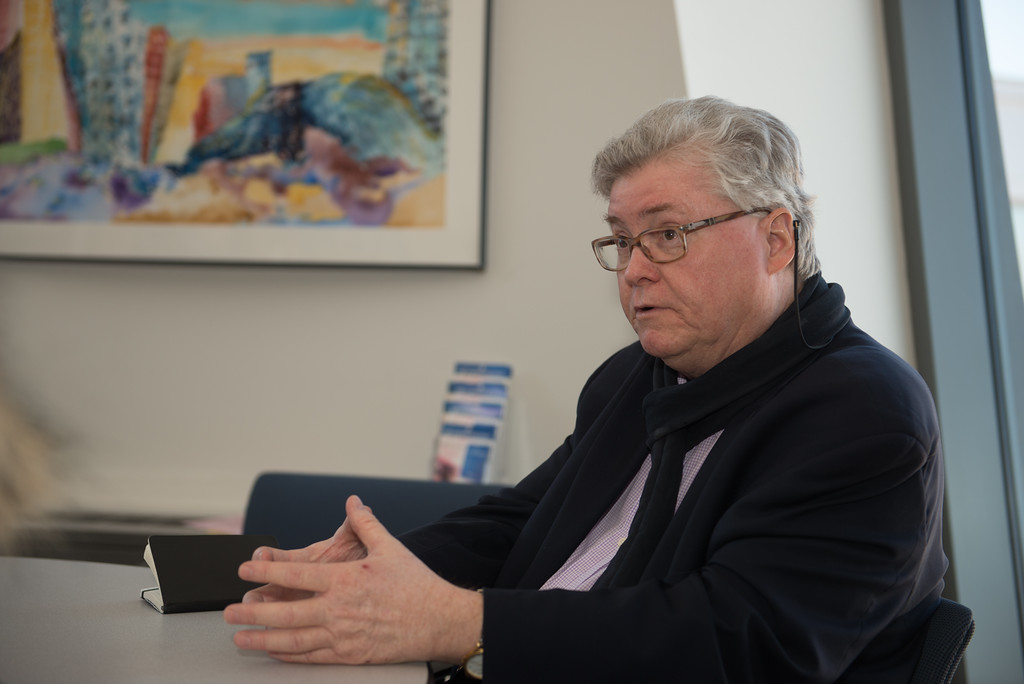For the past several years, Philosophy Professor David Pettigrew has been researching and writing about the genocide that took place during the Bosnian War in the 1990s, focusing particularly on the widespread and systematic efforts to exclude Bosnian Muslims from their former homes. Through his writing, lectures and a film on which he collaborated with his son, Pettigrew has expressed his deep involvement in efforts to gain recognition of the atrocities that took place in Bosnia.
During a three-week visit to the region this summer, Pettigrew served as a volunteer faculty member with Summer University Srebrenica, a summer research opportunity for students from around the world. His lecture for the opening ceremonies on July 1 at the Bosniak Institute in Sarajevo was titled, “Referring to the Crime By Its Proper Name: Genocide and Its Continuation in Srebrenica, Višegrad, Prijedor. ” He also presented a paper titled “After Genocide: Activism in a post-genocide community: Resisting Genocide Denial in Višegrad,” at Srebrenica-Potočari Memorial Center.
During the course of his research activities and field trips with the students, Pettigrew helped receive and unload 175 coffins containing the remains of victims exhumed and identified in previous years, in preparation for the burials on July 11. In his own words:
“This year I helped again to unload the coffins from the tractor trailer trucks when they arrived. There were 175 coffins containing the human remains of the victims of the Srebrenica genocide who had been exhumed from the mass graves and identified. The coffins arrived on July 9 in advance of their move to the cemetery on July 10 for the burial on July 11. When the trucks arrived from the morgue in Visoko, I joined the line of men moving the coffins from the trucks into the warehouse (located on the grounds of the Potočari Memorial Center).
“After this process was completed, I was lingering at the head of the rows of coffins when a man came over and introduced himself. He seemed to recognize me as he said “You are Professor David?” I said yes. We stood there awhile. I asked if he was burying his relatives. He said no, not this year, but that he had lost all male members of his family in the genocide. He then said he survived one of the mass executions, at a site known as Petkovci dam, and showed me his wounds. He was shot three times but fell under someone else who was killed. There he was left for dead, but one other man who was less severely wounded also survived and managed to drag him to safety. He told me he returned to live and work in Srebrenica as an act of defiance.
“At some point he looked at me and said: ‘When they bound us and loaded us on the truck we thought they were taking us to a detention center in Bijeljina…who would think that they were going to kill us all? … It didn’t make any sense…who would think of such a thing?’ As he said this, he looked at me like he still could not believe it happened, it was still incomprehensible to him.
“Stories like his and those of many others I meet in Bosnia and in the U.S. stiffen my resolve and motivate me to tell the truth about the genocide and the ongoing human rights violations.”
To this end, Pettigrew will deliver the keynote address for an international conference in Prague, Czech Republic, on Oct. 24 and 25: “The Suppression of Collective Memory and Identity in Bosnia: Prohibited Memorials and the Continuation of Genocide.” The conference is sponsored by the Charles University (Prague) Faculty of the Humanities.
Below are links to several recent media reports or blog postings about Pettigrew’s research:
- On July 13, he investigated a commemorative plaque honoring indicted war criminal Ratko Mladić that had been installed in the hills above Sarajevo in late May or early June 2014. (See home page photo and photo of plaque.) The plaque is located on a hill seized by the Bosnian Serbs in April 1992 as strategic high ground for their attacks on the city of Sarajevo and is situated between what was a sniper position (to the right) and tank position (to the left).
- An op-ed piece about the plaque written by Pettigrew for Al Jazeera Balkans:
http://balkans.aljazeera.net/vijesti/spomen-ploca-mladicu-nastavak-genocida
was also posted in English, on a blog in Sweden:
https://bosnienbloggen.wordpress.com/2014/08/20/mladic-plaque-in-east-sarajevo-a-continuation-of-the-genocide/ - An article focusing extensively on Pettigrew’s research:
http://balkans.aljazeera.net/vijesti/mladi-iz-svijeta-uce-o-genocidu was followed by a television report on Summer University Srebrenica:
http://tvsa.ba/ba/vijesti/videografiti_kao_podsjecanje_na_ulogu_un_vojnika_u_srebrenici - Prior to leaving for Bosnia, Pettigrew wrote a letter to the President of the International Criminal Tribunal for Yugoslavia, criticizing the decision to remove Višegrad (and other municipalities) from the genocide count of the indictment against former Bosnian Serb political leader Radovan Karadžić (supposedly in the interest of a more expeditious trial). His letter was designed to be released to the press for coverage on June 28, the same date in 1992 when the Serbs burned women, children, and elderly men alive in a house in the Bikavac neighborhood Višegrad. The court itself had identified that crime as “the worst acts of inhumanity that a person may inflict upon others.”
The letter to President Meron received press coverage in Bosnia, on Facebook, and on various blogs and websites.
http://www.klix.ba/vijesti/bih/profesor-pettigrew-uputio-pismo-predsjedniku-haskog-suda-u-povodu-22-godisnjice-zlocina-u-visegradu/140627052
http://bosnienbloggen.wordpress.com/2014/06/28/open-letter-to-icty-president-theodor-meron/
http://prijedorgenocide.com/professor-pettigrews-letter-to-theodor-meron/
http://instituteforgenocide.org/?p=8157
http://www.chicagoraja.net/?p=37124


